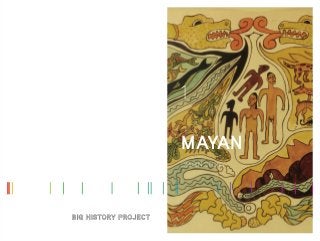
Unit 1: Origin Story: Mayan
- 2. THE POPOL VUH MAYAN Compiled by Cynthia Stokes Brown
- 3. 2 3 This origin story was told by the Mayans, who lived in the Yucatán Peninsula of Mexico from around 250 CE to 900 CE. It’s the beginning of a long, com- plex story called the Popol Vuh (literally the “council book”), first translated into alphabetic text from Mayan hieroglyphics in the 16th century. Now it still ripples, now it still murmurs, still sighs, and is empty under the sky. There is not yet one person, not one animal, bird, fish or tree. There is only the sky alone; the face of earth is not clear, only the sea alone is pooled under all the sky. Whatever might be is simply not there. There were makers in the sea, together called the Plumed Serpent. There were makers in the sky, together called the Heart of Sky. Together these makers planned the dawn of life. The earth arose because of them. It was simply their word that brought it forth. It arose suddenly, like a cloud unfolding. Then the mountains were separated from the water. All at once great mountains came forth. The sky was set apart, and the earth was set apart in the midst of the waters. Then the makers in the sky planned the animals of the mountains — the deer, pumas, jaguars, rattlesnakes, and guardians of the bushes. Then they established the nests of the birds, great and small. “You pre- cious birds; your nests are in the trees and bushes.” Then the deer and birds were told to talk to praise their makers, to pray to them. But the birds and animals did not talk; they just squawked and howled. So they had to accept that their flesh would be eaten by others. The makers tried again to form a giver of respect, a creature who would nurture and provide. They made a body from mud, but it didn’t look good. It talked at first but then crumbled and disintegrated into the water. Then the Heart of Sky called on the wise ones, the diviners, the Grand- father Xpiyacoc and the Grandmother Xmucane, to help decide how to form a person. The Grandparents said it is well to make wooden carvings, human in looks and speech. So wooden humans came into being; they talked and multiplied, but there was nothing in their minds and hearts, no memory of their builder, no memory of Heart of Sky. Then there came a great destruction. The wooden carvings were killed when the Heart of Sky devised a flood for them. It rained all day and all night. The animals came into the homes of the wooden carvings and ate them. The people were overthrown. The monkeys in the forest are a sign of this. They look like the previous people — mere wooden carvings. The story continues with the final people being made from corn, an important crop that enabled the Mayan people to move from being a hunting-and-gathering society to a more complex civilization.
- 4. 54 Sources Edited from Dennis Tedlock, Popol Vuh: The Mayan Book of the Dawn of Life Rev. ed. (New York: Simon and Schuster, 1996), 64 – 73. Image credits Creation by Diego Rivera © Christie’s Images/CORBIS
